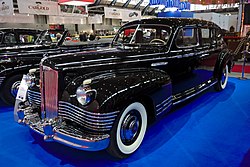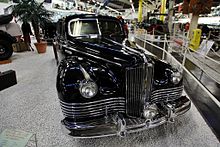ZIS-110
| ZIS | |
|---|---|
|
A ZIS-110 at the Retro Classics in Stuttgart (2018)
|
|
| ZIS-110 | |
| Production period: | 1946-1958 |
| Class : | Upper class |
| Body versions : | Pullman limousine , cabriolet , station wagon |
| Engines: |
Otto engine : 6.0 liters (103 kW) |
| Length: | 6000 mm |
| Width: | 1860 mm |
| Height: | 1730 mm |
| Wheelbase : | 3760 mm |
| Empty weight : | 2575 kg |
| Previous model | ZIS-101 |
| successor | ZIL-111 |
The ZIS-110 ( Russian ЗИС-110 ) is a luxury sedan made by the Soviet manufacturer Zavod imeni Stalina ( ZIS for short ). The vehicle was developed from 1942 as the successor to the ZIS-101 and was mass -produced from 1946 after the end of the Second World War . Due to the de-Stalinization, the limousines were called ZIL-110 from 1956 , just as the plant in Moscow was renamed Zavod imeni Lichatschowa . Production ran until 1958, during which time around 2100 ZIS-110 and ZIL-110 were manufactured in various versions. The look of the car is based on the Packard 180 from model year 1942. However, it is neither an exact copy nor a replica on American production facilities, as was partially the case with the predecessor. The successor was the ZIL-111 .
On the basis of the ZIS-110, at least 55 copies of an armored state body, the ZIS-115, were built .
Vehicle history


The outbreak of the German-Soviet War in the summer of 1941 brought the entire civil, still young Soviet car production to a standstill within a short period of time. This not only affected small and medium-sized vehicles such as the KIM-10 or the GAZ-M1 , but also the production of the luxury- class sedan ZIS-101 . The large automobile manufacturers such as the Sawod imeni Stalina or the Gorkowski Awtomobilny Sawod switched their production to military goods and until mid-1945 built almost exclusively trucks in addition to weapons. Nonetheless, a group of designers, also in response to political efforts, developed a successor model for the ZIS-101 as early as 1942.
Due to Stalin's personal preference , as with the predecessor, the orientation was based on American car models, this time on a vehicle from the manufacturer Packard , the Packard 180 from the last year of construction in 1942. With the predecessor, the Soviet engineers had bought machines from the USA . The ZIS-110 produced its own molds and pressing tools for the body parts. Various small changes to the design could also be made. Most obvious were the running boards, which were completely omitted on the ZIS-110. There was also no spare wheel on the fender, as was still available on the 1941 Packard 180 . Various chrome parts have been adjusted, in particular the front bumper and the moldings on the fenders. In fact, even the large sheet metal parts and the body have been changed, which means that they are not interchangeable between vehicles. In particular, the lines of the window edges were designed differently in detail. The engine is also different than in the Packard.
The first prototype was completed immediately after the end of the war and was ready to drive on July 20, 1945. A few automobiles were manufactured by the end of the year, the start of production was also delayed because the plant was also developing new trucks such as the ZIS-150 and buses such as the ZIS-154 and putting them into series production. From 1946 the ZIS-110 was built in series. In 1949, after a corresponding development phase, production of the ZIS-110B, the open Phaeton version of the passenger car, began. Further prototypes followed, for example individual vehicles with all-wheel drive were built for the military using parts from light all-wheel-drive trucks . Except for the armored sedan, the ZIS-115 , none of the prototypes made it to series production.
Even after Stalin's death in the spring of 1953, the car continued to be built. Khrushchev initiated de-Stalinization in 1956 , whereby his name also disappeared from the factory names in the automotive industry and the type designations. The Sawod imeni Stalina (ZIS) became the Sawod imeni Lichatschowa (ZIL), the ZIS-110 became the ZIL-110. Soviet literature of the late 1950s more or less completely omits the designation ZIS and names the sedans ZIL-110 regardless of the year of construction, although this is historically incorrect. The production of the ZIL-110 ended in 1958 and there are no conclusive references to production going beyond this in Soviet literature, although years of construction up to 1961 are occasionally mentioned.
The ZIS-110 was available to the highest representatives of the Soviet Union and the heads of state of the states allied with it. For example, on his 75th birthday in 1951 , the President of the GDR Wilhelm Pieck was presented with a seven-seater ZIS-110 convertible , but there had also been ZIS-110 vehicles in the GDR before that. They also came to Cuba and various Soviet republics. In particular, the open models were still in use at military parades and similar occasions even after production had ended, in some cases until the 1980s. A total of at least 2089 ZIS-110s were built, including about 100 Phaetons and 32 copies of the ZIS-115. In fact, the number was probably slightly higher because at least 55 of the armored variant were produced. From 1958 the much more modern ZIL-111 was built as a successor model. This, too, followed in style and technology the model of an American road cruiser, the Packard Patrician built between 1955 and 1956.
Model variants
During the twelve years of production there were several versions of the vehicle. Some were only produced in small numbers or remained prototypes.
- ZIS-110 - basic version with body as a sedan, built from 1945/46 to 1958.
- ZIS-110A - ambulance version, an ambulance . A patient can be transported lying down; the trunk lid has been modified for this.
- ZIS-110B - Model with a Phaeton body , built in series from 1949 to 1958. The vehicles were fitted with celluloid side windows or light plug-in windows with wooden frames. This model was preferred for military parades and similar occasions, sometimes up to the 1980s.
- ZIS-110W - Also known as ZIS-E110W , the E stands for experimental. Prototype of a convertible with fixed side windows from 1957, serial production did not take place, development probably came too late. Only with the successor was there a production version as a convertible, the ZIL-111W .
- ZIS-110P - In 1956 at least two four-wheel drive vehicles were produced, one with a sedan body and the other as a Phaeton. For the four-wheel drive, parts from the drive train of the GAZ-62 and GAZ-63 trucks were used .
- ZIS-110Sch - built for the army as early as 1949 either as a prototype or as a small series. Also with all-wheel drive, but with parts from a Dodge WC51 .
- ZIS-110 Taxi - Some vehicles were painted accordingly and used as a taxi . Among other things, they ran in official operation on the long-haul Moscow - Simferopol .
- ZIS-110 Kombi - An official designation does not exist, but photos of vehicles with combi bodies. The intended use has not been proven; like the ZIS-110A, they may have been used as an ambulance or as a hearse .
- ZIS-115 - Armored version as a sedan and Soviet state body.
Technical specifications
For the basic version ZIS-110.
- Engine: water-cooled eight-cylinder in-line four-stroke petrol engine
- Motor type: "ZIS-110"
- Power 140 hp (103 kW) at 3600 min -1
- Displacement: 6005 cm³
- Bore: 90.0 mm
- Stroke: 118.0 mm
- maximum torque: 392 Nm at 3200 min -1
- Compression: 6.85: 1
- Mixture preparation: carburettor, type "MKS-L3"
- Firing order: 1–6–2–5–8–3–7–4
- Starter: ST-10, 1.2 hp
- Alternator: G16, 35 A, 225 W.
- On-board voltage: 6 V.
- Clutch: single-plate dry clutch
- Transmission: mechanical three-speed manual gearbox, synchronized
- Top speed: 140 km / h
- Fuel consumption: 23 l / 100 km at a constant 60 km / h
- Acceleration from 0 ... 100 km / h: 28 s
- Brakes: drum brakes front and rear with vacuum brake booster , hand brake acting on the rear axle
- Drive formula : 4 × 2 (rear wheel drive)
Dimensions and weights
- Length: 6000 mm
- Width: 1960 mm
- Height: 1730 mm (with empty weight)
- Wheelbase: 3760 mm
- Front track: 1520 mm
- Rear track: 1600 mm
- minimum ground clearance: 210 mm
- Turning circle: 15.2 m diameter
- Seats: 7
- Dry weight : 2450 kg
- Empty weight: 2575 kg
- Payload: 525 kg
- permissible total weight: 3100 kg
- Front axle load: 1450 kg
- Rear axle load: 1650 kg
- Tire size: 7.00–16 ″ or 7.50–16 ″
literature
- Michael Dünnebier and Eberhard Kittler: Passenger cars of socialist countries. Transpress VEB Verlag for Transport, Berlin 1990, ISBN 3-344-00382-8 .
- LM Shugurov: АВТОМОБИЛИ России и СССР . First part. Ilbi / Prostreks, Moscow 1993, ISBN 5-87483-004-9 .
- LM Shugurov: АВТОМОБИЛИ России и СССР . Second part. Ilbi / Prostreks, Moscow 1994, ISBN 5-87483-006-5 .
- A. Sharkova (Editor-in-Chief): Автолегенды СССР: ЗИС-110 . No. 16, DeAgostini, Moscow 2009.
- Konstantin Andrejew: Автолегенды СССР: ЗИС-110Б . No. 108, DeAgostini, Moscow 2013.
- Ministry of Automobile Transport of the RSFSR ; Vehicle Construction Institute NIIAT: Short Automobile Manual (краткий автомобильный справочник). Transport publisher, 1st edition, Moscow 1958.
- Ministry of Automobile and Tractor Industry of the USSR; Zavod imeni Stalina: Автомобиль ЗИС-110. Инструкция по уходу и эксплуатации. 2nd edition, Maschgis, Moscow 1948. (Official operating instructions for the vehicle, edited by AN Ostrowzew, the chief designer of the ZIS-110.)
Individual evidence
- ↑ LM Shugurow: АВТОМОБИЛИ России и СССР . First part, various pages.
- ↑ a b c d e f g h A. Scharkowa (editor-in-chief): Автолегенды СССР: ЗИС-110 . P. 3 ff.
- ↑ a b Ministry of Automobile Transport of the RSFSR ; Vehicle Construction Institute NIIAT: Short Automobile Manual (краткий автомобильный справочник). P. 71 ff.
- ↑ LM Shugurow: АВТОМОБИЛИ России и СССР . Second part, p. 48 f.
- ↑ Model of the Soviet motor vehicle industry: The passenger car SIS-110 in: Motor vehicle technology 4/1952, p. 111.
- ↑ Konstantin Andrejew: Автолегенды СССР: ЗИС-110Б . P. 3 ff.
- ↑ Photograph of a ZIS-110 with a combination body
- ^ Ministry of Automobile and Tractor Industry of the USSR; Zavod imeni Stalina: Автомобиль ЗИС-110. Инструкция по уходу и эксплуатации. P. 7 ff.
Web links
- ZIL factory halls: from a Soviet production giant to a ghost factory . RBTH, August 12, 2017.





